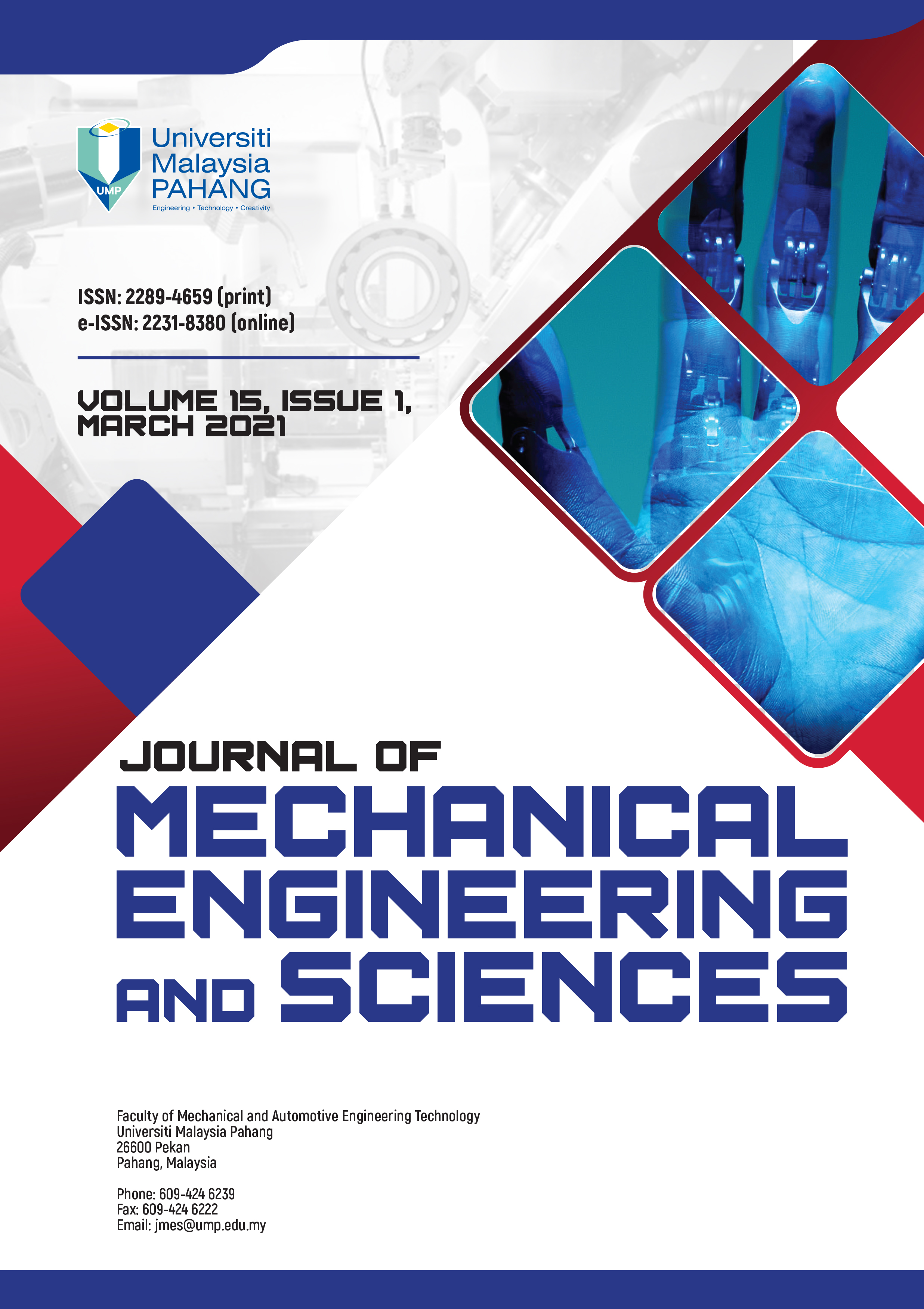Magnetorheological damper voltage control using artificial neural network for optimum vehicle ride comfort
DOI:
https://doi.org/10.15282/jmes.15.1.2021.03.0603Keywords:
Ride comfort, Full vehicle model, eight DOF model, MR damper, ANNAbstract
Suspension system design is an important challenging duty that facing car manufacturers, so the challenge has become to design the best system in terms of providing ride comfort and handling ability under all driving situations. The goal of this paper is to provide assistance in enhancing the effectiveness of the suspension system. A full car model with eight degrees of freedom (DOF) was developed using MATLAB/Simulink. Validation of the Simulink model was obtained. The model was assumed to travel over a speed hump that has a half sine wave shape and amplitude that changing from 0.01 to 0.2 m. The vehicle was moving with variable speeds from 20 to 120 km/h. Magneto Rheological (MR) damper was implanted to the model to study its effect on ride comfort. Artificial Neural Network (ANN) was used to find the optimum voltage value applied to the MR damper, to skip the hump at least displacement. This network uses road profile and the vehicle speed as inputs. A comparison of the results for passive suspension system and model with MR damper, are illustrated. Results show that the MR damper give significant improvements of the vehicle ride performance over the passive suspension system.
References
S. Qamar, L. Khan, Z. Qamar, “Online adaptive full car active suspension control using b-spline fuzzy-neural network,” 2013 11th International Conference on Frontiers of Information Technology, Islamabad, pp. 205-210, 2013, doi: 10.1109/FIT.2013.45.
J. Campos, F. Lewis, L. Davis, S. Ikenaga, “Backstepping based fuzzy logic control of active vehicle suspension systems,” Proceedings of the 2000 American Control Conference. ACC (IEEE Cat. No.00CH36334), vol. 6, pp. 4030-4035, 2000, doi: 10.1109/ACC.2000.876979
A. Florin, M.-R. Ioan-Cozmin, P. Liliana, “Pasive suspension modeling using matlab, quarter car model, imput signal step type,” TEHNOMUS - New Technologies and Products in Machine Manufacturing Technologies, pp. 258-263, 2013
G. Georgiou, G. Verros, S.Natsiavas, “Multi-objective optimization of quarter-car models with a passive or semi-active suspension system,” International Journal of Vehicle Mechanics and Mobility, vol. 45, pp. 77-92, 2007, doi: 10.1080/00423110600812925.
R. Darus and N. I. Enzai, “Modeling and control active suspension system for a quarter car model,” International Conference on Science and Social Research, pp. 1203-1206, December 2010, doi: 10.1109/CSPA.2009.5069178.
R. Kalaivani, K. Sudhagar, P. Lakshmi, “Neural network based vibration control for vehicle active suspension system,” Indian Journal of Science and Technology, vol. 9, pp. 1-8, 2016, doi: 10.17485/ijst/2016/v9i1/83806.
ErvinAlvarez-Sánchez, “A quarter-car suspension system: car body mass estimator and sliding mode control,” Procedia Technology, vol. 7, pp. 208-214, 2013, doi: 10.1016/j.protcy.2013.04.026.
A. Abd-Elsalam, M. A. El-Gohary, H. A. El-Gamal, “Simulation of nonlinear quarter car suspension system with and without tire damping,” International Journal of Advanced Scientific and Technical Research , pp. 98-105, 2016
Devdutt, “Passenger body vibration control in active quarter car model using hybrid anfis pid controller,” I.J. Intelligent Systems and Applications, vol. 10, no. 5, pp. 51-60, 2018, doi: 10.5815/ijisa.2018.05.06.
A. Kanjanavapastit and AphirakThitinaruemit, “Estimation of a speed hump profile using quarter car model,” Procedia-Social and Behavioral Sciences, vol. 88, pp. 265-273, 2013, doi: 10.1016/j.sbspro.2013.08.505.
W. Gao, N. Zhang, J. Dai, “A stochastic quarter-car model for dynamic analysis of vehicles with uncertain parameters,” International Journal of Vehicle Mechanics and Mobility, vol. 46, no. 12, pp. 1159-1169, 2008, doi: 10.1080/00423110701884575.
W. Abbas, A. S. Emam, S. Badran, O. Abouelatta, “Optimal seat and suspension design for a half-car with driver model using genetic algorithm,” Intelligent Control and Automation, vol. 4, no. 2, pp. 199-205, December 2012, doi: 10.4236/ica.2013.42024.
H. Souilem, S. Mehjoub, N. Derbel, “Intelligent control for a half-car active suspension by self-tunable fuzzy inference system,” International Journal of Fuzzy Systems and Advanced application, vol. 18, no. 3, pp. 9-15, 2015.
F. León-Vargas, F. Garelli, M. Zapateiro, “Limiting vertical acceleration for ride comfort in active suspension systems,” Journal of Systems and Control Engineering, pp. 223-232, 11 December 2017, doi: 10.1177/0959651817745469.
H. Khodadad and H. Ghadiri, “Self-tuning PID controller design using fuzzy logic for half car active suspension system,” International Journal of Dynamics and Control, vol. 6, no. 1, pp. 224-232, March 2018, doi: 10.1007/s40435-016-0291-5.
S. Y. Moon and W. H. Kwon, “Genetic-based fuzzy control for automotive active suspensions,” Proceedings of IEEE 5th International Fuzzy Systems, vol. 2, pp. 923-929, 1996, doi: 10.1109/FUZZY.1996.552302.
L. E. Sakman, R. Guclu, N. Yagiz, “Fuzzy logic control of vehicle suspensions with dry friction nonlinearity,” Sdhana, vol. 30, no. 5, pp. 649-659, october 2005, doi: 10.1007/BF02703512.
K. J.Wakeham and D. G. Rideout, “Model complexity requirements in design of half car active suspension controllers,” The American Society of Mechanical Engineers ASME, Dynamic system and control conference, pp. 839-846, October – November 2011, doi: 10.1115/DSCC2011-5955.
V. Goga and M. Kľúčik, “Optimization of vehicle suspension parameters with use of evolutionary computation,” Procedia Engineering, vol. 48, pp. 174 - 179, 2012, doi: 10.1016/j.proeng.2012.09.502.
W. Sun, H. Gao, O. Kaynak, “Adaptive backstepping control for active suspension systems with hard constraints,” IEEE/ASME Transactions on Mechatronics, vol. 18, no. 3, pp. 1072-1079, 2013, doi: 10.1109/TMECH.2012.2204765.
E.Esmailzadeh and F.Fahimi, “Optimal adaptive active suspensions for a full car model,” International Journal of Vehicle Mechanics and Mobility , vol. 27, no. 2, pp. 89-107, 1997, doi: 10.1080/00423119708969324.
J. Park and Y. Kim, “Decentralized variable structure control for active suspensions based on a full-car model,” IEEE International Conference on Control Applications, pp. 383-387, 1998, doi: 10.1109/CCA.1998.728460.
Y. H. Jung, J. W. Choi, Y. B. Seo, “Overlapping decentralized EA control design for an active suspension system of a full car model,” Proceedings of the 39th SICE Annual Conference, pp. 85-90, 26-28 july 2000, doi: 10.1109/SICE.2000.889658.
S. Ikenaga, F. Lewis, J. Campos, L. Davis, “Active suspension control of ground vehicle based on a full-vehicle model,” Proceedings of the 2000 American Control Conference, pp. 4019-4024, 28-30 june 2000, doi: 10.1109/ACC.2000.876977.
R. Guclu, “Active suspension control of eight degrees of freedom vehicle model,” Mathematical and Computational Application, vol. 9, no. 1, pp. 1-10, April 2004, doi: 10.3390/mca9010001.
A. Farazandeh and R. Kazemi, “Fuzzy control for active suspension in adams/car full vehicle,” IEEE Proceedings of the 25th Chinese Control Conference, pp. 1188-1193, 7-11 August 2006, doi: 10.1109/CHICC.2006.280602.
R. Darus and Y. Sam, “Modeling and control active suspension system for a full car model,” IEEE 5th International Colloquium on Signal Processing & Its Applications, pp. 13-18, 6-8 march 2009, doi: 0.1109/CSPA.2009.5069178.
L. Khan, S. Qamar, M. U. Khan, “Neuro-fuzzy wavelets based network for full car active suspension system,” IEEE International Conferance on Engineering Technologies, 8-9 October 2012, doi: 10.1109/ICET.2012.6375430.
S. Qamar, L. Khan, S. Ali, “Adaptive b-spline based neuro-fuzzy control for full car active suspension system,” Middle-East Journal of Scientific Research, vol. 16, no. 10, pp. 1348-1360, 2013, doi: 10.5829/idosi.mejsr.2013.16.10.11842.
Salem M.M.M, “Full car model active suspension system with PID and fuzzy controls to improve ride comfort,” Journal of American Science, vol. 9, no. 12, pp. 633-645, 2013.
J. Wang and C. Song, “Computer simulation on fuzzy control of semi-active suspension system based on the whole vehicle,” International Journal of Multimedia and Ubiquitous Engineering, vol. 8, no. 6, pp. 217-228, 2013, doi: 10.14257/ijmue.2013.8.6.22.
A. Geweda, M. El-Gohary, A. El-Nabawy, T. Awad, “Improvement of vehicle ride comfort using genetic algorithm optimization and pi controller,” Alexandria Engineering Journal, vol. 56, no. 4, pp. 405-414, 2017, doi: 10.1016/j.aej.2017.05.014.
Z. Yang, S. Liang, Y. Zhou, D. Zhao, “Sliding mode control for vibration comfort improvement of a 7-dof nonlinear active vehicle suspension model,” Journal of Robotics and Mechatronics, vol. 31, no. 1, pp. 95-103, 2019, doi: 10.20965/jrm.2019.p0095.
A. Shirahatti, P. S. S. Prasad, P. Panzade, M. Kulkarni, “Optimal design of passenger car suspension for ride and road holding,” Journal of the Brazilian Society of Mechanical Sciences and Engineering, March 2008, doi: 10.1590/S1678-58782008000100010.
M. Montazeri-Gh, S. Y. Jazayeri-M, M. Soleymani, “Vehicle ride evaluation based on a time-domain variable speed driving pattern,” International Journal of Vehicle Design, vol. 47, no. 1-4, pp. 81-101, October 2008, doi: 10.1504/IJVD.2008.020881.
R. Guclu, “Active control of seat vibrations of a vehicle model using various suspension alternatives,” Turkish Journal of Engineering and Enviromental Sciences, vol. 27, pp. 361-373, 2003.
E. Attia, N.M. Elsodany, H. Elgamal, M. Elgohary, “Theoretical and experimental study of magneto-rheological fluid disc brake,” Alexandria Engineering Journal, vol. 56, pp. 189-200, 2017, doi: 10.1016/j.aej.2016.11.017.
B. Sapiński and J. Filuś, “Analysis of parametric models of MR linear damper,” Journal of Theoretical and Applied Mechanics, vol. 41, no. 2, pp. 215-240, 2003.
M. El-Kafafy, S. El-Demerdash, M. Rabeih, “Automotive ride comfort control using MR fluid damper,” Engineering, vol. 4, no. 4, pp. 179-187, 2012, doi: 10.4236/eng.2012.44024.
M. A. El-Gohary, B. M. El-Souhily, S. F. Rezeka, T. Awad, “Generalized neural inverse dynamics model for front-wheel mid-size passenger car,” International Review of Mechanical Engineering, vol. 5, no. 3, p. 474, March 2011.
M. Nagarkar, M. Elgohary, Y. J. Bhalerao, G. J. V. Patil, R. N. Z. Patil “Artifcial neural network predication and validation of optimum suspension parameters of a passive suspension system,” SN Applied Sciences, 2019, doi: 10.1007/s42452-019-0550-0.
S. Yildirm and İ. Eski, “Vibration analysis of an experimental suspension system using artificial neural networks,” Journal of Scientific and Industrial Research, vol. 68, no. 6, pp. 522-529, 2009, doi: 10.4271/2009-01-0734.
Downloads
Published
How to Cite
Issue
Section
License
Copyright (c) 2021 The Author(s)

This work is licensed under a Creative Commons Attribution-NonCommercial 4.0 International License.






